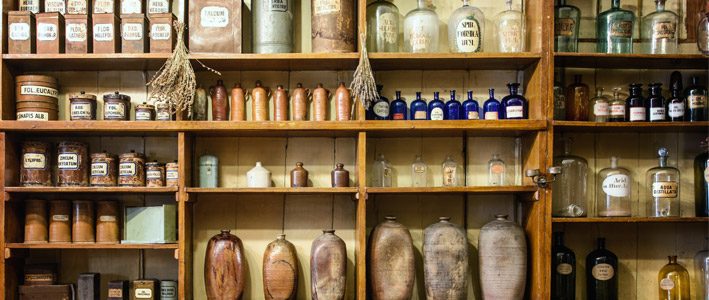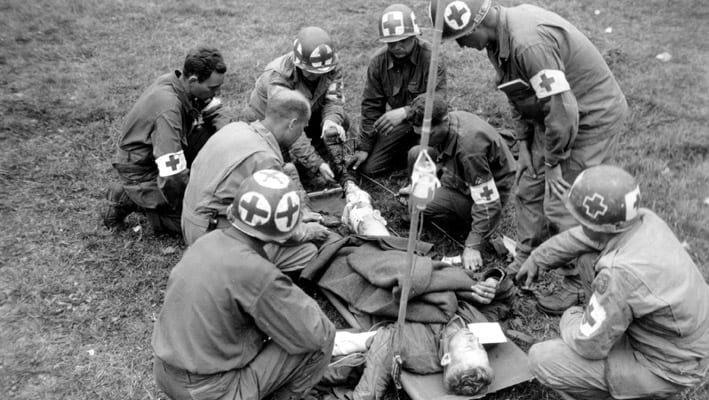© Tryfonov / Adobe Stock
The evolution of medicines shows how society has changed over the years. The search to combat disease gathered momentum during the 19th century, when rapid advances in science and the invention of modern equipment, such as the stethoscope and electrocardiogram, changed the face of medical care.
Although it’s impossible to say exactly when herbs and plants were first used for medicinal purposes, historians believe the practice may date back to Neanderthal times, around 450,000 years ago. Medicine can be traced back definitively 9,000 years, when dentistry, the oldest medical profession, was first recorded.
In the modern era, life expectancy in Britain has increased from between 30 and 40 years in the early 19th century to 82 years today. The earlier figure took into account the fact that death in childbirth was a common occurrence, with both the mother and baby being lost.
In 19th-century Europe, every third child died before the age of five, a mortality rate of 33%. Today, the child mortality rate has fallen to 0.3% in the UK.
In the late 19th century, the Industrial Revolution led to the growth of immense wealth, as a result of Britain’s booming trade and industry. This created extra money to spend on public health and medical research.
Early medicines
Before the days of antibiotics, natural herbal medicines were used to treat all ailments – a practice known as herbalism. The medicinal knowledge base developed over the centuries and was handed down between generations.
Historians believe Neanderthals may have had some form of medical practitioners, as the tribal culture had shamans and apothecaries, who assumed the role of healer.
Archaeological digs have unearthed fossilised Neanderthals with evidence of healed traumas. This suggested they had recovered from serious injuries and survived, despite physical impairment. Scholarly authors believe that Neanderthals, as a society with strong social bonds, provided primitive medical treatment and healthcare.
The first known dentistry dates to 7000 BC in Baluchistan, in south-west Asia, when Neolithic dentists would use flint-tipped drills and bowstrings to carry out dental work. One can only imagine the pain of having an extraction!
In ancient Mesopotamia, medicine combined science and magic, with doctors prescribing medicinal treatments and magical verses, which must be recited simultaneously. The first prescriptions date from Sumer from around 2112 BC.
The Ancient Egyptians and the Babylonians were the first civilisations to introduce physical examination, diagnosis, prognosis and remedy. Ancient Egypt, in particular, developed a varied and effective medical system.
The Ancient Greek historian, Herodotus, described the Egyptians as “the healthiest of all men”, not only because of the dry climate but also due to their “notable public health system”.
First medical school
The famous Greek physician, Hippocrates of Kos, born in around 460 BC, is known as the “Father of Medicine”. He founded the first medical school, the Hippocratic School of Medicine, in Ancient Greece.
Prior to his research, medicine had been a discipline closely associated with philosophy and theurgy – the practice of ancient magical rituals. Hippocrates established medicine as a profession in its own right. His father, Heraclides, was also a physician, who passed down his knowledge.
In turn, Hippocrates’ students included his sons Draco and Thessalus and his son-in-law Polybus, all of whom became physicians. Polybus went on to found the Dogmatic School of Medicine. Hippocrates recognised cancer, calling it “karcinos”. He also describes diphtheria, mumps, jaundice and other medical conditions.
The Greek physician Aelius Galenus, better known as Galen of Pergamon, was born in 129 AD. He describes treatments for breast cancer, including the surgical removal of early-stage tumours, but without the aid of modern medicines, the surgeries were primitive and often unsuccessful.
First vaccine
It wasn’t until the late 18th century that the first modern medicines were developed. English physician and scientist Edward Jenner pioneered the world’s first vaccine against smallpox in the 1790s. Smallpox was a prevalent killer disease at the time.
Jenner, born in Berkeley in 1849, was apprenticed at age 14 to surgeon Daniel Ludlow, of Chipping Sodbury, Gloucestershire, for seven years. Jenner gained enough experience to become a surgeon himself.
He developed the smallpox vaccine after noting that milkmaids appeared immune to the disease. He realised that they were exposed to cowpox, which is a similar disease to smallpox, although less virulent, and they often had infected blisters on their hands through milking. This had built up antibodies that left them immune to smallpox.
Jenner created his vaccine using cowpox samples taken from the hands of milkmaid Sarah Nelmes, who had caught the disease from a cow called Blossom. Cowpox began in milkmaids with inflamed spots on the hands and wrists, which initially resembled a burn mark, but soon turned into blisters. The disease would cause violent headaches and a temperature. Although it could be fatal, once the fever had subsided, there were no further eruptions on the skin.
Jenner’s vaccine was first used on eight-year-old James Phipps, the son of his gardener, with an injection in his arm on 14th May 1796. Phipps developed a mild fever, which soon subsided, but remained immune to smallpox. Jenner further developed his successful vaccine and it was made available by 1798.
The remains of Blossom the cow have been preserved at St George’s medical school library in Tooting, recognising the important role she played in this medical milestone.
First nursing school
The social reformer and nurse Florence Nightingale was the founder of modern nursing. Born in 1820 to wealthy English parents in Florence, Italy, she was named after her birthplace. When she was one year old, the family moved back to England.
Nightingale was brought up at Embley in Hampshire, where she developed a humanitarian outlook. In 1837, at the age of 17, she decided to devote her life to serving others.
She told her family she intended to become a nurse, but they opposed this, as a woman of her social status was expected to become a wife and mother. Nursing was considered by society as being beneath her. As a young woman, she had to respect her parents’ wishes, but in 1844, at the age of 24, Nightingale rebelled and began to educate herself on the art of nursing and science, despite her mother’s distress.
She was so determined to become a nurse that she turned down a proposal from poet and politician Richard Monckton Milnes, who had courted her for nine years. She decided marriage would interfere with her career plans and so remained single.
Nightingale came to the public’s attention during the Crimean War, from 1853 to 1856. Now in her 30s, she famously became known as the “Lady with the Lamp”, after nursing wounded soldiers in the war hospitals.
A report in The Times newspaper described her as an “angel”, who could be seen every night “gliding quietly along each corridor”, a lamp in her hand, checking on the patients, long after the medical officers had retired for the night.
On 29th November 1855, the Nightingale Fund was launched to train nurses, in recognition of Nightingale’s valuable work in the war. Using £45,000 from the Nightingale Fund, she set up the Nightingale Training School, the first nurses’ training establishment, at St Thomas’ Hospital on 9th July 1860.
The first nurses who had trained there began work at the Liverpool Workhouse Infirmary on 16th May 1865. Today, the Florence Nightingale School of Nursing and Midwifery is part of London’s King’s College.
19th-century discoveries
The medical profession developed in the 19th century, with new methods of diagnosing and treating patients being introduced. A chemical test was developed which identified the presence and quantity of sugar in urine.
The stethoscope enabled physicians to detect certain forms of heart disease by listening to the patient’s heartbeat. Problems such as double beats, defective valves and other anomalies could be detected by the trained physician.
The concept of the stethoscope had been invented by French physician Réné Laënnec in 1816 and two centuries later, his original idea remains the basis for modern stethoscopes, but the fully electronic stethoscope today can amplify sounds up to 14 times greater than a standard model.
The field of diagnostics enabled physicians to identify medical conditions more accurately, but before the invention of penicillin and antibiotics, patient care was not of today’s standards.
An understanding of disease improved in the 19th century, thanks to scientists such as Louis Pasteur of France, whose research in the 1860s discovered that germs and bacteria cause diseases. A spin-off from his research was the pasteurisation of milk, which killed the germs and stopped it from going sour.
German scientist Robert Koch and his assistant Julius Petri discovered which bacteria caused which diseases, prompting the invention of the Petri dish, where bacteria was grown. Koch discovered which bacteria caused Anthrax, TB, septicaemia and cholera.
Further 19th-century research discovered more bacteria, including typhoid, pneumonia and the plague. French scientist Charles Chamberland discovered viruses in 1884, after recognising there were dangerous organisms even smaller than bacteria.
Birth of penicillin
The first true antibiotic, penicillin, was invented in 1928 by Alexander Fleming. It changed the face of medicine, as prior to this, there wasn’t an effective treatment for infections such as gonorrhoea, pneumonia, rheumatic fever and blood poisoning contracted from a cut.
Hospitals were full of seriously ill people, but with only basic treatments, the doctors could do little to save them. Then, on 3rd September 1928, Fleming was examining Petri dishes containing Staphylococcus, a bacteria which causes sore throats, boils and abscesses.
He noticed that in one area, a blob of mould had secreted a substance that inhibited the bacteria’s growth. The mould was later identified as Penicillium notatum, which was capable of killing many harmful bacteria, such as meningococcus, streptococcus and the diphtheria bacillus.
Fleming and his assistants, Frederick Ridley and Stuart Craddock, began the task of isolating pure penicillin from the mould. Without their painstaking research, the medicines that we know today wouldn’t exist.
Further research into the benefits of penicillin was carried out by scientists at Oxford University. The valuable work on purifying penicillin began in 1939.
More research was carried out in the United States, after the large-scale production of penicillin for clinical trials was impossible in the UK, due to depleted funds as a result of the second world war.
Penicillin finally went on sale to the British public, as a prescription-only drug, on 1st June 1946, revolutionising healthcare and the treatment of once-fatal diseases.
Today, cold stores remain a vital part of research into medicines and the storage of pharmaceutical drugs. 1COLD Ltd provides temperature-controlled environments for the medical and pharmaceutical sector. Please contact us for further information.




